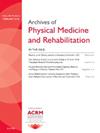不同医院、学科和经验的员工对患者动员障碍的感知各不相同:一项多站点横断面调查。
IF 3.6
2区 医学
Q1 REHABILITATION
Archives of physical medicine and rehabilitation
Pub Date : 2025-01-01
DOI:10.1016/j.apmr.2024.09.004
引用次数: 0
摘要
目的描述医护人员在逐步动员患者时遇到的障碍:设计:横断面员工调查:澳大利亚一家大型医疗服务机构的 4 家医院的 10 个内科病房:护理、医疗和专职医疗人员:不适用 主要测量患者动员态度和信念调查。计算障碍总分以及知识、态度和行为的分量表得分,并在不同医院、学科和临床经验年限之间进行比较:208 名参与者(123 名护士、27 名医疗人员和 58 名专职医疗人员)完成了调查,其中 104 人(50%)的工作经验不足 5 年。最大的障碍包括护理工作量、医嘱不到位以及患者和家属对动员的抵触。不同医院、不同学科(护理学科平均分为 50 [SD 7],医学学科平均分为 51 [SD 7],专职医疗人员平均分为 43 [SD 7])和不同临床经验年限的员工对障碍的总体评价也不尽相同(结论:不同医院、不同学科和不同临床经验年限的员工对护理工作量、医嘱不到位和病人及家属对动员的抵触程度等障碍的感知不同:员工认为护理工作量、缺乏医嘱以及患者和家属的抵触情绪是患者动员的最大障碍。在同一医疗服务机构中,不同学科、不同经验水平和不同医院之间的障碍得分各不相同。知识分量表上的得分较低,这凸显出除了教育之外,还需要针对文化和制度采取多成分策略;教育可能尤其有利于医务人员。本文章由计算机程序翻译,如有差异,请以英文原文为准。
Staff-Perceived Barriers to Patient Mobilization Vary by Hospital, Discipline, and Experience: A Multisite Cross-Sectional Survey
Objective
To describe staff-perceived barriers to progressive patient mobilization.
Design
Cross-sectional staff survey.
Setting
Ten internal medicine wards in 4 hospitals in a large health service.
Participants
Nursing, medical, and allied health staff (n=208).
Interventions
Not applicable.
Main Outcome Measures
Patient Mobilization Attitudes and Beliefs Survey. An overall barriers score and subscale scores for knowledge, attitudes, and behaviors were calculated and compared between hospitals, discipline, and years of clinical experience.
Results
The survey was completed by 208 participants (123 nurses, 27 medical, 58 allied health), of whom 104 (50%) had <5 years of experience. The greatest perceived barriers included nursing workload, medical orders not being in place, and patient and family resistance to mobilization. Overall barrier scores differed between hospitals, discipline (mean nursing score ± SD 50±7; mean medical score ± SD, 51±7; mean allied health score ± SD, 43±7), and years of clinical experience (<5y mean score ± SD, 50±7; 5-9y mean score ± SD, 47±7; ≥10y mean score ± SD, 46±8); significant differences by hospital and discipline persisted in multivariate analysis. The behavior subscale had the highest barriers score and knowledge the lowest across all subgroups.
Conclusions
Staff-perceived nursing workload, lack of medical orders, and patient and family resistance to be the greatest barriers to patient mobilization. Barrier scores differed between disciplines, experience levels, and across hospitals within a single health service. Lower scores on the knowledge subscale highlight the need for multicomponent strategies beyond education that address culture and systems; education may particularly benefit medical staff.
求助全文
通过发布文献求助,成功后即可免费获取论文全文。
去求助
来源期刊
CiteScore
6.20
自引率
4.70%
发文量
495
审稿时长
38 days
期刊介绍:
The Archives of Physical Medicine and Rehabilitation publishes original, peer-reviewed research and clinical reports on important trends and developments in physical medicine and rehabilitation and related fields. This international journal brings researchers and clinicians authoritative information on the therapeutic utilization of physical, behavioral and pharmaceutical agents in providing comprehensive care for individuals with chronic illness and disabilities.
Archives began publication in 1920, publishes monthly, and is the official journal of the American Congress of Rehabilitation Medicine. Its papers are cited more often than any other rehabilitation journal.

 求助内容:
求助内容: 应助结果提醒方式:
应助结果提醒方式:


